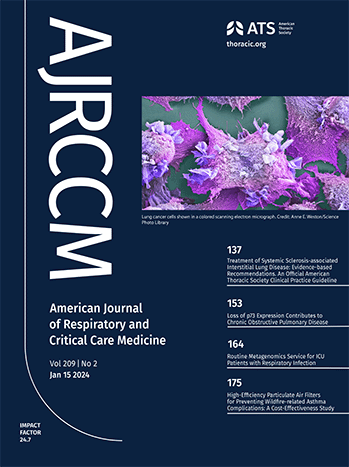呼吸系统易感性增加的蛋白质组风险评分:一项多队列研究
IF 19.3
1区 医学
Q1 CRITICAL CARE MEDICINE
American journal of respiratory and critical care medicine
Pub Date : 2024-09-10
DOI:10.1164/rccm.202403-0613oc
引用次数: 0
摘要
理论依据肺功能加速下降与慢性阻塞性肺病、住院和死亡有关。方法在 CARDIA(一个始于青年期的人群队列)中,使用 FEV1 预测百分比的纵向测量值(30 年中最多有 6 个时间点)来识别加速下降和正常下降轨迹。通过多变量逻辑回归和 LASSO 回归确定了与加速衰退轨迹相关的蛋白质配体。根据这些循环蛋白得出了蛋白质组呼吸系统易感性评分,并将其应用于英国生物库和 COPDGene 研究,以检查与未来呼吸系统发病率和死亡率的关系。测量和结果较高的易感性评分与全因死亡率(英国生物库:HR 1.56,95%CI 1.50-1.61;COPDGene:HR 1.75,95%CI 1.63-1.88)、呼吸系统死亡率(英国生物库:HR 2.39,95%CI 2.16-2.64;COPDGene:HR 1.83,95%CI 1.33-2.51)、慢性阻塞性肺疾病事件(UKBB:HR 1.84,95%CI 1.71-1.98)、呼吸系统恶化事件(COPDGene:OR 1.11,95%CI 1.03-1.20)和需要住院治疗的恶化事件(COPDGene:OR 1.18, 95%CI 1.08-1.28)。结论呼吸系统易感性增加的蛋白质组特征可识别呼吸系统死亡、慢性阻塞性肺病和呼吸系统恶化的高危人群。这种易感性评分由与肺部健康相关的知名和新型蛋白质组成,有望用于早期检测肺部疾病,而无需进行多年的肺活量测量。本文章由计算机程序翻译,如有差异,请以英文原文为准。
Proteomic Risk Score of Increased Respiratory Susceptibility: A Multi-Cohort Study.
RATIONALE
Accelerated decline in lung function is associated with incident COPD, hospitalizations and death. However, identifying this trajectory with longitudinal spirometry measurements is challenging in clinical practice.
OBJECTIVE
To determine whether a proteomic risk score trained on accelerated decline in lung function can assess risk of future respiratory disease and mortality.
METHODS
In CARDIA, a population-based cohort starting in young adulthood, longitudinal measurements of FEV1 percent predicted (up to six timepoints over 30 years) were used to identify accelerated and normal decline trajectories. Protein aptamers associated with an accelerated decline trajectory were identified with multivariable logistic regression followed by LASSO regression. The proteomic respiratory susceptibility score was derived based on these circulating proteins and applied to the UK Biobank and COPDGene studies to examine associations with future respiratory morbidity and mortality.
MEASUREMENTS AND RESULTS
Higher susceptibility score was independently associated with all-cause mortality (UKBB: HR 1.56, 95%CI 1.50-1.61; COPDGene: HR 1.75, 95%CI 1.63-1.88), respiratory mortality (UKBB: HR 2.39, 95% CI 2.16-2.64; COPDGene: HR 1.83, 95%CI 1.33-2.51), incident COPD (UKBB: HR 1.84, 95%CI 1.71-1.98), incident respiratory exacerbation (COPDGene: OR 1.11, 95%CI 1.03-1.20), and incident exacerbation requiring hospitalization (COPDGene: OR 1.18, 95%CI 1.08-1.28).
CONCLUSIONS
A proteomic signature of increased respiratory susceptibility identifies people at risk of respiratory death, incident COPD, and respiratory exacerbations. This susceptibility score is comprised of proteins with well-known and novel associations with lung health and holds promise for the early detection of lung disease without requiring years of spirometry measurements.
求助全文
通过发布文献求助,成功后即可免费获取论文全文。
去求助
来源期刊
CiteScore
27.30
自引率
4.50%
发文量
1313
审稿时长
3-6 weeks
期刊介绍:
The American Journal of Respiratory and Critical Care Medicine focuses on human biology and disease, as well as animal studies that contribute to the understanding of pathophysiology and treatment of diseases that affect the respiratory system and critically ill patients. Papers that are solely or predominantly based in cell and molecular biology are published in the companion journal, the American Journal of Respiratory Cell and Molecular Biology. The Journal also seeks to publish clinical trials and outstanding review articles on areas of interest in several forms. The State-of-the-Art review is a treatise usually covering a broad field that brings bench research to the bedside. Shorter reviews are published as Critical Care Perspectives or Pulmonary Perspectives. These are generally focused on a more limited area and advance a concerted opinion about care for a specific process. Concise Clinical Reviews provide an evidence-based synthesis of the literature pertaining to topics of fundamental importance to the practice of pulmonary, critical care, and sleep medicine. Images providing advances or unusual contributions to the field are published as Images in Pulmonary, Critical Care, Sleep Medicine and the Sciences.
A recent trend and future direction of the Journal has been to include debates of a topical nature on issues of importance in pulmonary and critical care medicine and to the membership of the American Thoracic Society. Other recent changes have included encompassing works from the field of critical care medicine and the extension of the editorial governing of journal policy to colleagues outside of the United States of America. The focus and direction of the Journal is to establish an international forum for state-of-the-art respiratory and critical care medicine.

 求助内容:
求助内容: 应助结果提醒方式:
应助结果提醒方式:


